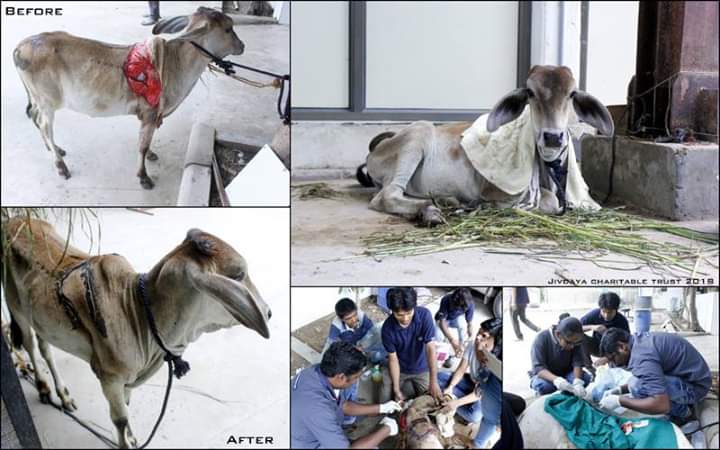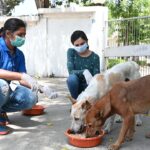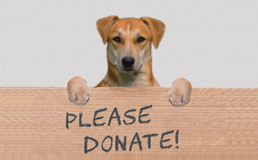Deep Laceration in a Calf

The culture of this ancient land sees divinity in the 3 holy ‘Ga’: Geeta, Ganga and Gaay (cow). No matter what part of the country you reside in, the sight of a herd of cattle being shepherded by a herder with a long bamboo stick in hand would be a common sight for you. Moreover, you must have surely seen cows tied outside some temples, being fed green fodder by ardent devotees who touch her with reverence. Within Shivalayas, a stone sculpture of the sacred bull- Nandi- rests just outside the sanctum sanctorum (Garbha Grih). Nandi is the mythic guardian-gatekeeper of Himalaya, the abode of Mahadev.
Going beyond the religious importance, cow is not just another animal. It is not just sacred. Its importance stems from its pivotal role in rural economy. First of all, cow nourishes with her milk. It can be further processed into butter, cheese, ice-cream, yoghurt, lassi and butter-milk. All this generates revenue and for some families this is how they make a living. Bull and ox play a vital role too in transportation and farming.
The holy cow’s contribution goes even further as cow dung is used as a fuel and effective fertilizer in many villages. There are some manufacturers who utilize cow urine for its purported anti-bacterial properties and make a floor disinfectant infused with herbs. In most rural households with domestic cattle, a bovine falling sick will evoke similar emotions as the sudden illness of a pet dog would in the western world.
Cow slaughter, though largely banned in most parts of the country, is an emotive issue. Cattle theft and illegal slaughterhouses continue to exist in some numbers despite high penalties and severe crackdown. Astonishingly, violence, even full-blown riots, have occurred when cows have been targeted by non- Hindus resulting into deaths of over hundred. Perhaps, nowhere in the world can one find one animal bringing out such passionate emotions as well as being highly integrated with the lives of many in the villages.
Sounds like a fairy tale, doesn’t it? You can almost hear the soothing music of Lord Krishna’s flute that would enchant the cattle and maidens of Mathura alike!
Sadly, the high ideals of human society like compassion, care and love are dependent on utility and practicality. Behind the carefully crafted imagery of Cow-Krishna-Love lies a dark and bloody macabre of inhuman treatment, horrific animal cruelty, selfishness of epic proportions, blind greed and utter absence of humanness. For instance, cows are dying a slow, painful death in every city of Bharat due to ingesting polythene bags. These cows look for food in open garbage bins and ingest polythene bags which often contain vegetable waste. Over 20 kilos of such toxic bags have been removed from the stomach of a few cattle lucky enough to get timely medical help.
Once a cow stops lactating due to old age, she is often abandoned on the roads or highways where she often falls victim to vehicular accident. Cow sheds run by non-government organizations are more often than not overflowing with such abandoned cattle. Stray cattle in the city are impounded by municipal authorities but the owners never show up as this is a popular way to get rid of a burden. The male calves inevitably feel the butcher’s cold, often dull, steel blade against their dewlap before their tongue has got used to the soft, but often abused, udders of their mother.
Take for instance this pitiful baby. She was brought in with a severe laceration all the way from the hump to the right side of the shoulder and up to the elbow joint. Suspected to have met with an accident, she had got a deep-seated wound. The supraspinatus muscle was badly severed and the wound was contaminated with mud and dirt.
Doctors and the assistants had to first flush the wound thoroughly, to clean it properly before it could be sutured back together. While the wound was sutured closed, doctor had to leave a passive drain for the excess discharge and exudation.
The calf is currently on antibiotics and painkillers. She has started eating and is recovering slowly. Once she recovers enough, she will be shifted to larger Panjrapole (cattle shelter) for a better and safer life.
This shockingly common apathy leads to a long-drawn end of life after untold misery. It begets a question, isn’t a quick, clean death better than such a wretched life? Are we the biggest hypocrites for worshipping an animal in our temples, but abusing them like commodities otherwise? Will we ever learn we do not own the blue planet? Is it too late to maintain a balance with Nature?
Such jarring instances of animal abuse have led to the rise of movements like ‘veganism’, ‘say no to meat’, ‘veg for life’ and other endeavours that aim to sensitize people about animal cruelty and urge them to quit all animal products including silk and honey too.
The point here is not of morality or what one “should” do. It doesn’t aim to rouse your spirit into making a life altering decision. People who do try to do that, often ending up isolating themselves because. Well, this is a personal choice. But whether you decide to top your mocha frappe with whipped cream or learn to enjoy your pizza without cheese for a lifetime, you should know the facts and learn the whiteness of milk contains a lot of blackness too.







